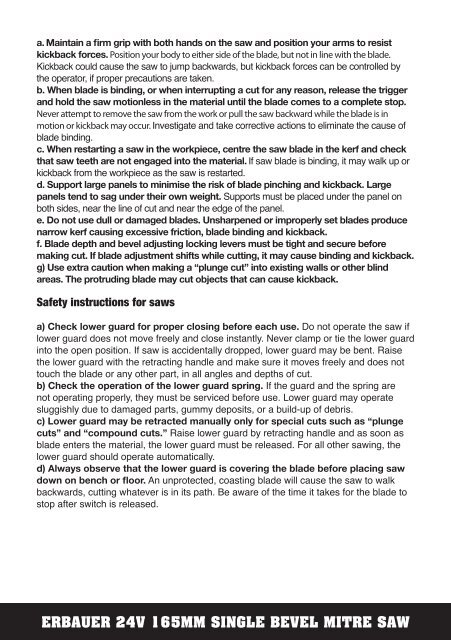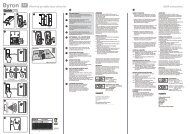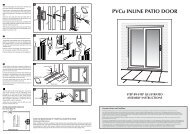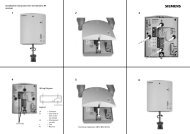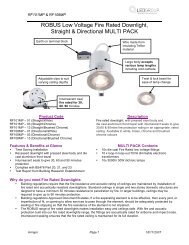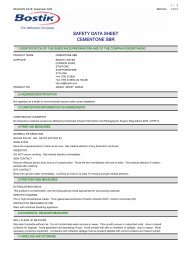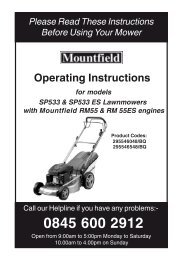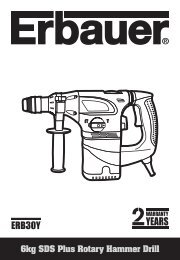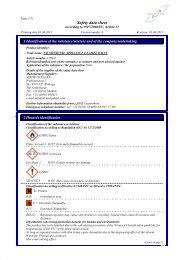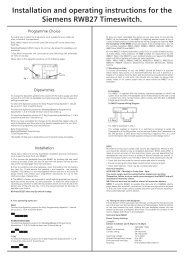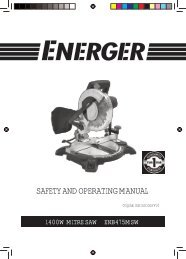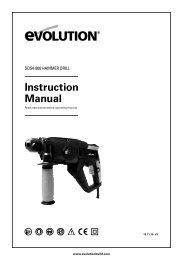ERF298MSW - Free-Instruction-Manuals.com
ERF298MSW - Free-Instruction-Manuals.com
ERF298MSW - Free-Instruction-Manuals.com
You also want an ePaper? Increase the reach of your titles
YUMPU automatically turns print PDFs into web optimized ePapers that Google loves.
a. Maintain a firm grip with both hands on the saw and position your arms to resist<br />
kickback forces. Position your body to either side of the blade, but not in line with the blade.<br />
Kickback could cause the saw to jump backwards, but kickback forces can be controlled by<br />
the operator, if proper precautions are taken.<br />
b. When blade is binding, or when interrupting a cut for any reason, release the trigger<br />
and hold the saw motionless in the material until the blade <strong>com</strong>es to a <strong>com</strong>plete stop.<br />
Never attempt to remove the saw from the work or pull the saw backward while the blade is in<br />
motion or kickback may occur. Investigate and take corrective actions to eliminate the cause of<br />
blade binding.<br />
c. When restarting a saw in the workpiece, centre the saw blade in the kerf and check<br />
that saw teeth are not engaged into the material. If saw blade is binding, it may walk up or<br />
kickback from the workpiece as the saw is restarted.<br />
d. Support large panels to minimise the risk of blade pinching and kickback. Large<br />
panels tend to sag under their own weight. Supports must be placed under the panel on<br />
both sides, near the line of cut and near the edge of the panel.<br />
e. Do not use dull or damaged blades. Unsharpened or improperly set blades produce<br />
narrow kerf causing excessive friction, blade binding and kickback.<br />
f. Blade depth and bevel adjusting locking levers must be tight and secure before<br />
making cut. If blade adjustment shifts while cutting, it may cause binding and kickback.<br />
g) Use extra caution when making a “plunge cut” into existing walls or other blind<br />
areas. The protruding blade may cut objects that can cause kickback.<br />
Safety instructions for saws<br />
a) Check lower guard for proper closing before each use. Do not operate the saw if<br />
lower guard does not move freely and close instantly. Never clamp or tie the lower guard<br />
into the open position. If saw is accidentally dropped, lower guard may be bent. Raise<br />
the lower guard with the retracting handle and make sure it moves freely and does not<br />
touch the blade or any other part, in all angles and depths of cut.<br />
b) Check the operation of the lower guard spring. If the guard and the spring are<br />
not operating properly, they must be serviced before use. Lower guard may operate<br />
sluggishly due to damaged parts, gummy deposits, or a build-up of debris.<br />
c) Lower guard may be retracted manually only for special cuts such as “plunge<br />
cuts” and “<strong>com</strong>pound cuts.” Raise lower guard by retracting handle and as soon as<br />
blade enters the material, the lower guard must be released. For all other sawing, the<br />
lower guard should operate automatically.<br />
d) Always observe that the lower guard is covering the blade before placing saw<br />
down on bench or floor. An unprotected, coasting blade will cause the saw to walk<br />
backwards, cutting whatever is in its path. Be aware of the time it takes for the blade to<br />
stop after switch is released.<br />
ERBAUER 24V 165MM SINGLE BEVEL MITRE SAW


